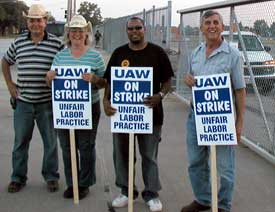
Follow workers.org on



RED HOT: TRAYVON MARTIN
CHINA,
AFGHANISTAN, FIGHTING RACISM, OCCUPY WALL STREET,
PEOPLE'S POWER, SAVE OUR POST OFFICES, WOMEN, AFRICA,
LIBYA, WISCONSIN WORKERS FIGHT BACK, SUPPORT STATE & LOCAL WORKERS,
EGYPT, NORTH AFRICA & MIDDLE EAST,
STOP FBI REPRESSION, RESIST ARIZONA RACISM, NO TO FRACKING, DEFEND PUBLIC EDUCATION, ANTI-WAR,
HEALTH CARE,
CUBA, CLIMATE CHANGE,
JOBS JOBS JOBS,
STOP FORECLOSURES, IRAN,
IRAQ, CAPITALIST CRISIS,
IMMIGRANTS, LGBT, POLITICAL PRISONERS,
KOREA,
HONDURAS, HAITI,
SOCIALISM,
GAZA



|
|
Bosses’ intransigence arouses resistance
73,000 striking GM workers fight for their jobs
By
Martha Grevatt
Published Sep 27, 2007 12:03 AM
Bulletin: On Sept. 26, General Motors and
the United Auto Workers announced a tentative settlement that ended the two-day
strike. The ripple effect of the two-day strike hurt GM. Buzz Hargrove,
president of the Canadian Auto Workers Union, said that GM production in his
country was coming to a standstill.
In the U.S., Teamsters were refusing to cross picket lines and other labor
support was growing. On the Sept. 29-30 weekend UAW members—only those
active at GM—will be eligible to vote to accept or reject the
agreement.
“You gotta do what you gotta do.” After being on strike a mere
eight hours, this General Motors (GM) worker summed up the feeling on the
picket line at the Parma, Ohio stamping plant.
“They want more, and there’s gotta be a point somewhere where you
say no,” another added.
They had been told on Monday, Sept. 24, to walk out at 11 a.m. if they
weren’t told otherwise. By 11:01 workers began streaming out of the
plants by the thousands. This is the first national strike against GM since
1976.
The core issue, according to United Auto Workers President Ron Gettelfinger, is
job security. Apparently the heads of GM are refusing to guarantee work to
those 73,000 remaining autoworkers at the company that once employed hundreds
of thousands.
It had been thought that if there was a strike it would be around the issue of
retiree health care costs. Yet the two sides had actually agreed on the details
on creating a VEBA—Voluntary Employee Beneficiary Association—to be
administered by the UAW. The VEBA would in the long run boost GM profits
incalculably, as it would relieve the company of future burdens of paying for
retiree benefits.
The VEBA represents a historic retreat from the position that obligated
automakers to provide health insurance to all employees and retirees, as well
as to their dependents. For more than half a million retired workers and loved
ones, the lifetime coverage they’ve grown accustomed to is at risk. If
the fund underperforms, it puts the UAW in the awkward position of cutting
benefits to those it is supposed to represent.
Yet rather than show appreciation to the UAW for coming to its rescue,
GM’s reported stance was that the more they give to the VEBA the less
they will be willing to preserve in the areas of wages and job security.
What inhumanity—asking the union to choose between job security or the
security of affordable health care! After working for decades at hard,
monotonous and at times dangerous work—work from which the Big Three
profited handsomely—why should anyone have to worry about becoming
underinsured?
GM provoked the strike
At the news conference announcing the strike, Gettelfinger pointed to the
concessions already made by autoworkers in the past four years:
“We’re shocked and disappointed that General Motors has failed to
recognize and appreciate what our membership has contributed during the past
four years. Since 2003 our members have made extraordinary efforts every time
the company came to us with a problem: the corporate restructuring, the
attrition plan, the Delphi bankruptcy, the 2005 health care agreement. In every
case, our members went the extra mile to find reasonable solutions.”
The bosses don’t care. Through no fault of the workers, domestic
automakers have lost market share—losing billions—or they are
seeing a radically diminished rate of profit. Dealers’ lots are
overflowing with gas-guzzling vehicles they can’t sell. GM, Ford and
Chrysler combined are nearly $100 billion in debt for their health care
obligations, and health insurance premiums are skyrocketing with no end in
sight. The auto barons want to take a huge bite out of labor costs no matter
how much or how many it hurts.
The corporation is determined to weaken the UAW with a severe cost-cutting
policy. Their strategy—expand global operations at the expense of the
North American work force.
In the midst of negotiations, GM arrogantly announced plans to build an $800
million state-of-the-art Buick plant in Shanghai. The global market is their
future and the plunge in the dollar will make their products cheaper and more
competitive, and expand operations abroad. The billions to be invested must
come at the expense of the GM workers’ jobs and benefits. Plants will be
shut down to lower costs and investments in the U.S.
The third party in all these negotiations, causing both sides to weigh their
options carefully, is the state of the capitalist economy. What began with the
sub-prime mortgage crisis has morphed into a generalized crisis of the
financial markets, causing lenders everywhere to tighten purse strings. Finance
capital is not inclined to be generous towards the workers in the higher-paid
manufacturing sector while its overall situation is precarious.
On the other hand, the economic crisis weighs heavily on the workers, many of
whom are mired in debt for homes, cars and college tuition. A rumored
$5-per-hour wage cut, for example, could put someone in the position of
choosing between taking their kid out of college or looking at foreclosure.
Even one more plant closing would spell disaster for a town in Michigan or
Ohio, where foreclosures are already the highest in the country.
No wonder the workers see a strike as “doing what you gotta
do.”
Whether the strike is short or long, in this context the display of
workers’ power by 73,000 UAW members has tremendous
significance—more than can even be known at this time.
ν
Articles copyright 1995-2012 Workers World.
Verbatim copying and distribution of this entire article is permitted in any medium without royalty provided this notice is preserved.
Workers World, 55 W. 17 St., NY, NY 10011
Email: [email protected]
Subscribe [email protected]
Support independent news DONATE
|
|


